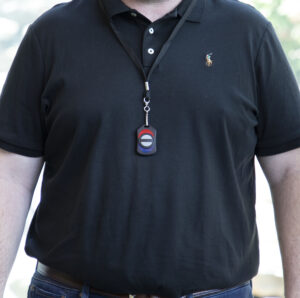
Mental Health Clinic Panic Button Buyer's Guide: 10 Questions to Ask Before You Buy
Every mental health professional knows that safety and care go hand in hand. Whether you’re a solo therapist in a small office, a counselor in a busy community clinic, or part of the staff in a residential treatment center, your work often places you shoulder to shoulder with people in some of the hardest moments of their lives. That vulnerability is exactly what makes the work so meaningful. But it’s also what makes safety such an important piece of the puzzle.
Unlike general medical settings, mental health facilities face unique challenges. Sessions are usually private. Emotions can be intense. Resources are often stretched thin. And for many organizations, there’s no dedicated security staff waiting just outside the door. That means the responsibility for safety often rests on the people doing the work: the clinicians, receptionists, case managers, and support staff.
Choosing the right safety system is about making sure you and your colleagues can focus on helping people heal, knowing that support is there if something ever goes wrong. Here are ten questions that can guide you toward finding the right fit for your facility.
Question 1: Can staff get help discreetly without alarming patients?
In therapy, trust is everything. Clients walk into your space carrying burdens they may not share anywhere else. If an emergency arises, the last thing you want is for a loud alarm to shatter that trust or escalate the situation further.
That’s why discretion matters. In a small therapy office, it might mean a therapist quietly signaling for help without their client ever knowing. In a larger clinic, it could mean a staff member summoning backup without disrupting group sessions or triggering panic in the waiting room. The best systems make it possible to ask for the exact kind of help you need (whether it’s medical, security, or administrative) without alarming the very people you’re there to protect.
- Does the system operate silently without audible alarms?
- Can staff request different types of assistance (medical, security, administrative) discreetly?
- Will patients be aware that an alert has been sent?
Question 2: How does it work when you’re understaffed or after hours?
Mental health care doesn’t keep business hours. Evening sessions, weekend appointments, and overnight residential shifts are part of the job. But during those times, staffing is often thinner. A front desk may be closed, or the one security officer on duty might be covering an entire campus.
That’s when a safety system really shows its value. The right system adapts to those moments when staff is stretched the thinnest, giving you peace of mind that help is always available; even if you’re the only one on site.
- Can the system alert external contacts when on-site staff is minimal?
- Does it work with your existing security service or answering service?
- Can you customize response protocols for different staffing levels?
Question 3: What’s the real total cost of ownership?
Budgets are tight everywhere in mental health. Whether you’re running a solo practice or overseeing a large network of clinics, the cost of any new system matters. But the sticker price doesn’t always tell the whole story. Some systems have setup fees, equipment charges, or per-user costs that add up quickly as your team grows. Others require expensive training or ongoing support contracts.
The right question to ask isn’t just what does it cost now? but what will it cost over time? The most sustainable systems are transparent, fair, and grow with you. They help you avoid surprises and make safety a long-term investment, not a financial strain.
- Are there setup fees, per-user charges, or equipment costs?
- What ongoing training or support is included vs. extra?
- How does pricing scale as your clinic grows?
Question 4: Can you customize alerts for different situations?
Anyone who’s worked in mental health knows that no two emergencies look the same. A therapist may need quiet backup when a session gets tense. A nurse may need immediate medical support. A receptionist may need help with a disruptive visitor. Treating every situation like it’s the same not only slows down the response but can also overwhelm the people trying to help.
That’s why flexibility matters. The best systems let you send different types of alerts (medical, security, or administrative) and indicate how urgent they are. They also escalate automatically if the first responder can’t answer, so you’re never left waiting.
- Can you set different alert types for medical emergencies vs. behavioral escalations?
- Can staff indicate severity levels when requesting help?
- Does the system allow for escalation if initial responders don’t acknowledge?
Question 5: Will your team actually use it in a crisis?
In a true crisis, there’s no time to fumble with complicated systems. Staff need something that feels second-nature; accessible on devices they already carry, simple to use, and reliable under pressure.
If people don’t feel comfortable with the tool, they won’t use it when they need it most. That’s why ease of use is as important as the technology itself. The best systems let you practice without fear of setting off a false alarm, so your team builds confidence long before they need it.
- Is it accessible on devices staff already carry (phones, tablets, computers)?
- How simple is it to activate under stress?
- Can you test it regularly without causing false alarms or confusion?
Question 6: Does it integrate with your existing safety protocols?
Every mental health facility already has some form of safety plan. It might be an emergency action plan posted in the break room, regular de-escalation training for staff, or existing security measures in the building. A new system should strengthen those efforts.
The right solution works alongside what you already have. It connects with security cameras or entry systems if you use them. It fits into your training and drills. And it provides the documentation you need for incident reports and compliance reviews. Instead of being “one more thing,” it becomes the tool that ties your safety protocols together.
- Can it work with your current security systems and cameras?
- Does it fit into your emergency action plans and staff training?
- Will it provide the documentation you need for incident reports and compliance?
Question 7: How does it help coordinate your response team during an incident?
Emergencies rarely affect just one person. In many facilities, multiple staff members may need to respond: a therapist inside a room, a receptionist in the lobby, and a supervisor managing the bigger picture. If communication is fragmented, the response slows down and mistakes happen.
That’s why coordination features are essential. The best systems allow responders to communicate in real time, confirm actions, and share updates as the situation unfolds. Whether it’s two colleagues in a small office or a team across multiple floors in a clinic, everyone stays on the same page.
- Does the system allow multiple responders to coordinate during incidents?
- Can staff confirm receipt of an alert in real time?
- Does it provide a shared communication channel for active situations?
Question 8: What support do you provide to ensure staff adoption?
No matter how good a system is, it won’t help if staff aren’t comfortable using it. Mental health professionals already juggle full workloads and emotional demands; if a safety tool feels complicated or intimidating, it risks being ignored.
That’s why support matters. A strong provider offers onboarding tailored to real-world scenarios in your facility, plus ongoing refreshers so staff stay confident. When staff know they can practice without fear of “messing up” and have someone to call if they need help, the system becomes part of the culture instead of a forgotten add-on.
- Does the provider offer hands-on training for staff?
- Is ongoing support included in the service?
- Can the system be tested regularly without risk of false alarms?
Question 9: What happens if internet/power goes out?
Emergencies don’t wait for perfect conditions. If your Wi-Fi fails or the power goes out, you still need to know that staff can reach help. This is especially critical for rural clinics, older buildings, or residential programs that run 24/7.
Reliable systems are built with backup options, like cellular connectivity when internet fails or battery-powered devices that keep working through an outage. Asking about redundancy ensures your safety net won’t vanish when you need it most.
- Does the system have a backup if Wi-Fi goes down?
- Can it function during a power outage?
- Does it store and forward alerts once service is restored?
Question 10: Can it work across multiple clinic locations?
Many mental health organizations operate in more than one place: sometimes across town, sometimes across an entire state. If each site uses a separate system, administrators lose visibility, and staff may be forced to learn different tools for different locations.
A scalable solution provides both local responsiveness and centralized oversight. Staff can use the same system whether they’re at the main office, a satellite clinic, or a partner location, while administrators can track and manage safety consistently across the organization.
- Does the system work seamlessly across multiple sites?
- Can administrators manage and review alerts organization-wide?
- Will staff have the same experience no matter which location they’re in?
A Safety Net That Lets You Focus on Care
At the end of the day, the reason you choose a safety system is because you want to feel safe enough to give your best to the people you serve. Whether you’re a solo therapist, a clinic administrator, or a residential care director, you deserve to know that if something goes wrong, you won’t face it alone.
That’s why so many facilities trust TeamAlert. TeamAlert was built with healthcare and mental health in mind. It allows staff to send discreet, customizable alerts from devices they already carry. It works just as well after hours as it does during the day. It scales affordably as your team grows, integrates smoothly into your existing safety plans, and automatically documents incidents for compliance and review. Most importantly, it gives your staff the confidence that they can call for help without disrupting care or breaking trust.
With TeamAlert in place, safety becomes the quiet foundation that allows your team to focus fully on what matters most: helping people heal, recover, and thrive.
If you want to see how TeamAlert can positively impact your practice, schedule a demo or try TeamAlert for free for 14 days.

